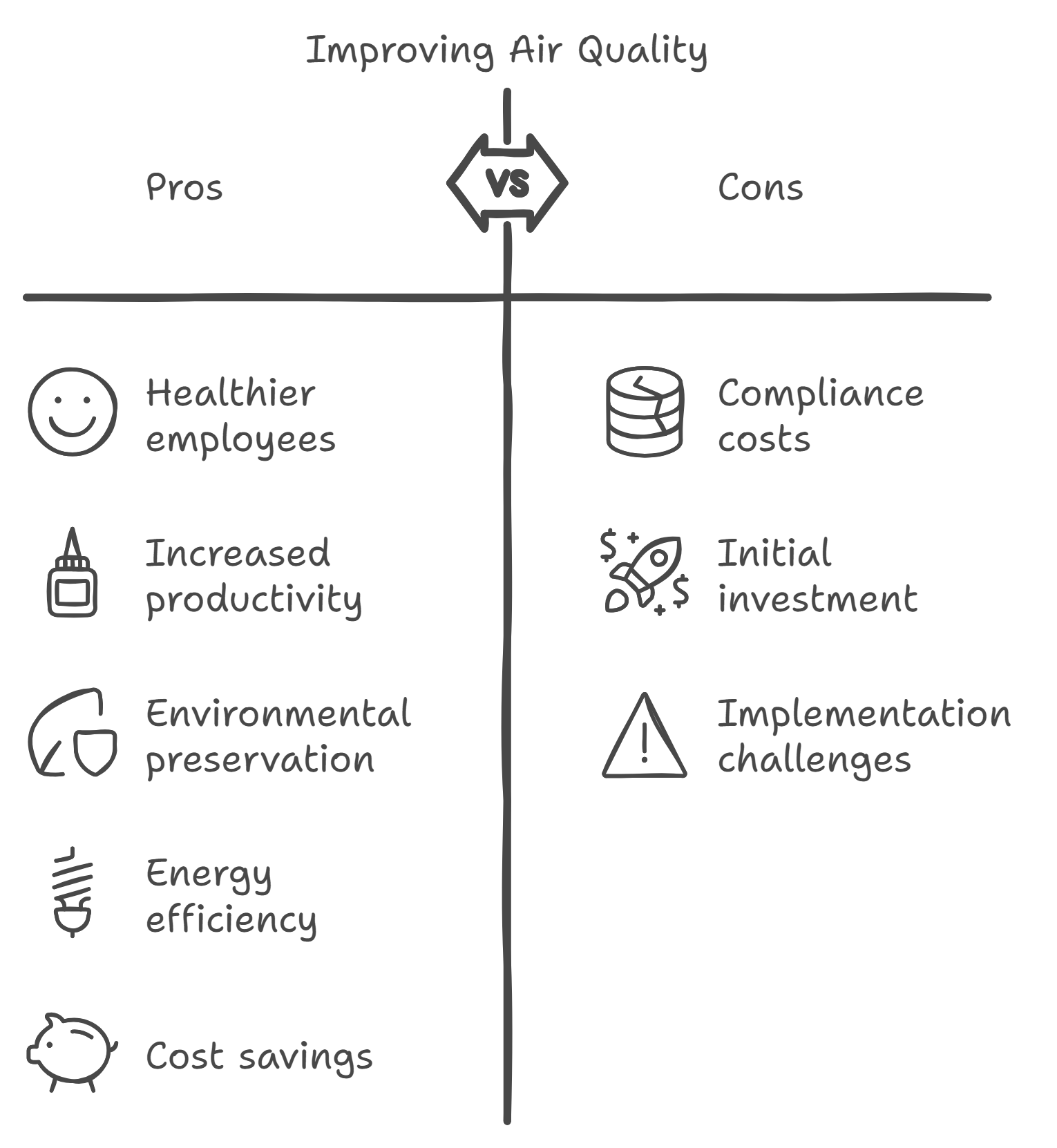September 23, 2024
Air Quality Regulations for Businesses in Canada

Air quality regulations for businesses in Canada are crucial yet often overlooked. These rules help keep the air clean and safe for everyone. Companies must follow strict guidelines to reduce pollution and protect public health. Some businesses excel at this, while others struggle to meet standards. Understanding these regulations can make a big difference in compliance and sustainability. This blog post will explore what businesses need to know about air quality laws in Canada, highlighting key aspects that impact operations and the environment. Stay informed and ensure your business is part of the solution, not the problem.
Overview of Air Quality Standards

Lack of Indoor Standards
Many Canadian jurisdictions lack specific indoor air quality legislation. This means there are no clear air pollution regulations or air standards for businesses to follow indoors. Without these standards, some workplaces may not have the best air conditions for employees, lacking proper heaters, utility boilers, and gaseous fuel management. Poor indoor air can affect health and productivity. To ensure a safe environment, it’s important for homeowners to consider residential air quality testing.
General Duty Clause
The “general duty clause” plays a key role in workplace safety. It requires employers to provide a safe environment. Even without specific air pollution regulations, businesses must ensure acceptable air quality, especially when using utility boilers and gaseous fuel. This clause helps protect workers from harmful air pollutants. For those managing large facilities, commercial air quality testing is essential to maintaining compliance and ensuring employee well-being.
Ventilation Requirements
Ventilation is crucial for good indoor air quality. It helps remove specific air contaminants from the workplace. Canadian laws and building codes include ventilation requirements. These rules ensure that fresh air circulates properly indoors. Proper ventilation reduces risks associated with poor air quality.
Key Air Pollutants and Their Impact

Common Indoor Pollutants
Indoor air can contain various pollutants. Volatile Organic Compounds (VOCs) are common. They come from paints, cleaning products, and building materials. Carbon monoxide is another indoor pollutant. It is produced by burning fuels like gas or wood in utility boilers, adhering to air pollution emission standards and air pollution regulations. Particulate matter, tiny particles in the air from gaseous fuel and utility boilers, can also be found indoors. These particles come from dust, smoke, or pollen. Identifying and mitigating such risks through mold testing services can help ensure a healthier indoor environment.
Health Impacts
Poor air quality can harm health. Breathing polluted air may cause respiratory issues like asthma or bronchitis. People with allergies might have more reactions due to high levels of air contaminants from gaseous fuel. Long-term exposure to pollutants like sulphur dioxide, despite air pollution regulations and emission standards, can lead to serious lung diseases.
Importance of Monitoring
Monitoring air quality is crucial for businesses. Keeping track of air pollution emissions from gaseous fuel helps protect employees’ health. Businesses should control pollutant levels to ensure safety. Regular checks, air pollution regulations, and proper ventilation systems can reduce harmful effects. Cement kilns, for example, need strict monitoring due to their emissions and air pollution regulation, especially when using gaseous fuel. Those looking for local solutions can find air testing professionals near their location to maintain compliance and safety.
Regulations for Indoor Environments

Occupational Health Standards
Canada’s Occupational Health and Safety Regulations focus on ensuring safe indoor environments and air pollution emission standards. These regulations cover HVAC systems, which are crucial for maintaining air quality when using gaseous fuel. They require regular maintenance and inspection of these systems to prevent harmful emissions, in accordance with air pollution regulation, especially when using gaseous fuel. This ensures that workplaces meet the necessary safety standards.
Provincial Differences
Indoor air quality regulations vary across provinces. In Ontario, strict guidelines ensure proper ventilation in workplaces. British Columbia has similar rules but emphasizes industrial emission requirements and air pollution regulation more. These differences highlight how provincial regulations adapt to local needs and industries.
CSA and ASHRAE Guidelines
Organizations like CSA and ASHRAE set standards for indoor air quality. CSA provides guidelines on air reference limits, ensuring pollutants remain below harmful levels. ASHRAE focuses on ventilation rates and thermal comfort. Together, they help businesses maintain a healthy environment indoors.
National and Provincial Emission Trends

National Trends
Canada tracks emissions through the National Pollutant Release Inventory. This program records data on pollutant emissions from various sectors for air pollution regulation. The inventory helps identify trends in air pollution across the country. For instance, nitrogen oxides are a major concern due to their impact on air quality.
The National Air Pollution Surveillance Program also plays a key role. It monitors air pollutants, providing valuable data for analysis. These programs guide national policies aimed at reducing emissions.
Provincial Emissions
Each province in Canada has its own regulations for air pollution. Provincial air pollution regulations vary based on local emission sources. They target specific industrial sectors that contribute heavily to pollution.
For example, provinces with many emission sources focus on air pollution regulation and reducing nitrogen emissions. This includes industries using stationary spark ignition systems powered by gaseous fuel and subject to air pollution emission standards. Such targeted regulations help manage local air quality effectively.
Government Initiatives
Government initiatives play a significant role in improving air quality. Pollution prevention plans encourage businesses to adopt low emission ratings. These plans aim to reduce harmful emissions from industrial activities.
Efforts are also made to control emissions from vehicles and other mobile sources. By promoting cleaner technologies, the government reduces overall pollutant emissions.
Benefits of Improving Air Quality

Health Benefits
Improved air quality brings many health benefits. Reduced levels of air pollution mean fewer respiratory problems. People breathe easier and stay healthier. This leads to less absenteeism at work. Healthy employees are more productive. Businesses see better performance when their staff is present and well.
Environmental Advantages
Cleaner air helps the environment too. Lower air emissions contribute to a smaller carbon footprint. This means less harm to the planet. Businesses that focus on reducing sulphur and other pollutants, adhering to air pollution emission standards, help preserve nature. Energy efficiency improves as well. By using cleaner technologies, companies save energy and resources. Additionally, communities benefit when local businesses take proactive steps to improve commercial air quality.
Cost Savings
There are financial benefits from managing air quality better. Compliance with regulations can avoid fines and penalties. Businesses save money by following rules about outdoor air pollution. Improved air quality can also lead to lower healthcare costs for employees. In some cases, insurance premiums may decrease when businesses show they care about environmental health.
Final Remarks
Understanding air quality regulations in Canada is crucial for your business. These standards protect health and ensure compliance. By knowing the key pollutants and their effects, you can create safer environments. Keeping up with national and provincial trends helps you stay ahead of regulations. Improving air quality isn’t just about compliance; it benefits everyone by enhancing well-being and productivity.
Take action now. Assess your current practices and make necessary changes to improve air quality. This proactive approach not only safeguards health but also boosts your business reputation. Stay informed and leverage these insights for a healthier, more sustainable future. Dive deeper into the topic and explore resources to keep your business aligned with the latest standards. Let’s make a positive impact together!
Frequently Asked Questions
What are the air quality standards in Canada?
Canada’s air quality standards are set to protect health and the environment. They focus on limiting pollutants like PM2.5, NOx, and SO2. Businesses must comply with these standards to ensure safe air.
Which key air pollutants affect businesses?
Key pollutants include particulate matter (PM), nitrogen oxides (NOx), sulfur dioxide (SO2), and volatile organic compounds (VOCs). These can harm health and productivity.
How do indoor air quality regulations impact businesses?
Indoor air quality regulations require businesses to maintain safe environments. Proper ventilation and regular monitoring help reduce risks from harmful pollutants indoors.
What are the trends in national and provincial emissions?
Nationally, emissions have declined due to stricter regulations. However, trends vary by province. Some areas face challenges due to industrial activities.
Why should businesses improve air quality?
Improving air quality boosts employee health and productivity. It reduces absenteeism and enhances workplace satisfaction, ultimately benefiting business performance.
How can businesses comply with air quality regulations?
Businesses can comply by monitoring emissions, using cleaner technologies, and following government guidelines. Regular audits ensure adherence to standards.
What benefits do businesses gain from reducing emissions?
Reducing emissions improves public image and meets regulatory requirements. It also contributes to a healthier community and environment, attracting eco-conscious customers.









